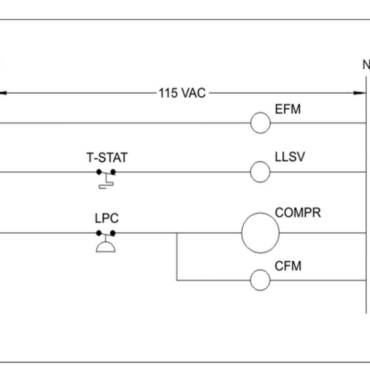Gary McCreadie is an HVAC tech, the creator of hvacknowitall.com and the HVAC Know It All Podcast
When I first started in the HVAC trade, wiring diagrams looked like a different language to me, that’s because they were. Not only were they a different form of communication but every manufacturer had their own way of drawing them out. This was confusing at times, as each manufacturer’s rendition was like a different dialect or accent of the same language.
I hope that analogy hits home with you because that’s exactly the way I felt and if you’re currently learning wiring diagrams, I’ve been there and have felt your frustration.
If we break it down to the most basic level, wiring diagrams are made up of images that tell a story, that story includes things like: order of operation as it pertains to flow of power, images of parts like fans, relays and compressors, power source, and all the interconnecting parts and wiring to complete them. They also contain legends to easily identify the parts within the drawing.
If you can understand wiring diagrams and understand them well, you can take your troubleshooting to the next level.
This is my first ever podcast episode and it was on basic electrical, forgive me as I was learning the podcast ropes.
Main Parts
Let’s focus our attention on the main parts of a basic wiring diagram.
- Power Supply
- Switches
- Loads
Power Supply
The power supply is the power source that feeds the circuit, the loads within a circuit are rated for a certain voltage, amperage, etc. The nameplate on the load will specify the information. For instance, if the load is rated for 208 VAC then the power supply serving that load must match or be within its limits. If the source is below or above the nameplate rating, the load will not perform correctly, or it can cause damage or failure to the load itself. Hint, a load is like a motor or compressor, but we’ll touch on that later. A power supply could come from batteries, a transformer or main electrical panel in a home or building.
Switches
Switches are simple devices that open and close due to an action, that action could be as simple as manually opening or closing the switch or can be a little more complicated, like switching in an automated process. Switches can be used to break an electrical circuit or provide power flow through them, switches are also rated for a maximum power supply that shouldn’t be exceeded when power is applied . An open switch is a switch that does not allow power to flow from one side to the other, a closed switch allows that same power to flow through it. You may hear the term, “contacts” when experienced professionals discuss switches. This simply means that the switch parts are coming into contact or breaking contact to make or break a circuit.
Examples of Switches
- High/Low Pressure Switch
- Relay/Contactor Contacts
- Flow Switch
- Pressure Switch
An example of a switch changing position in an automated process would be: if a boiler pump were to start and create flow through a system, an inline flow switch would recognize this and change the switches position from open to closed due to water flow passing by.
Loads
Loads usually sit at the end of a circuit, after power moves from the power supply through an inline switch or switches, the load or loads are powered up and begin to function. Loads are things like motors, compressors, contactor or relay coils and light bulbs. Loads perform work and draw amperage.
This basic wiring diagram includes all three main parts, power supply, switch and load.

Learning To Read Wiring Diagrams
In order to understand wiring diagrams, we need to understand the main components and their differences. I remember pulling panels as an apprentice and putting my finger on the power source and following the diagram until I came across a component, which was usually a switch or a load. I would then glance at the diagram legend to get an explanation of what my finger had stopped on. I would then follow the diagram until the end. I would sometimes call tech support if I was having trouble understanding a component’s functionality before moving on. Repeating this process diagram after diagram was definitely my key to success over the course of time to understanding electrical drawings and interpreting their meaning.
Check out this training video on how to read wiring diagrams, subscribe to the channel.
Gary McCreadie
Subscribe to the HVAC Know It All app
Follow HVAC Know It All on Instagram, Facebook, YouTube and LinkedIn and LISTEN to the HVAC Know It All Podcast
Save 8% on purchases at TruTech Tools with code knowitall (excluding Fluke and Flir products)
Save 8% at eMotors Direct with code HVACKNOWITALL












Whether you require installation, repair, or maintenance, our technicians will assist you with top-quality service at any time of the day or night. Take comfort in knowing your indoor air quality is the best it can be with MOE heating & cooling services Ontario's solution for heating, air conditioning, and ventilation that’s cooler than the rest.
Contact us to schedule a visit. Our qualified team of technicians, are always ready to help you and guide you for heating and cooling issues. Weather you want to replace an old furnace or install a brand new air conditioner, we are here to help you. Our main office is at Kitchener but we can service most of Ontario's cities
Source link







Add Comment